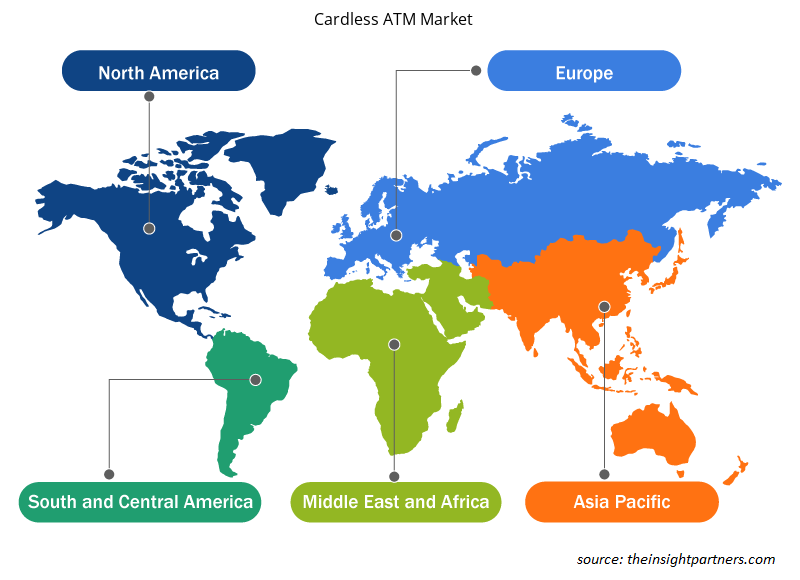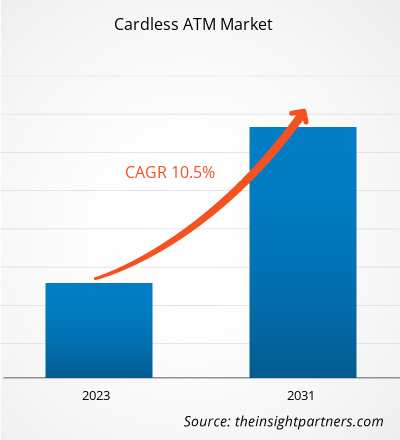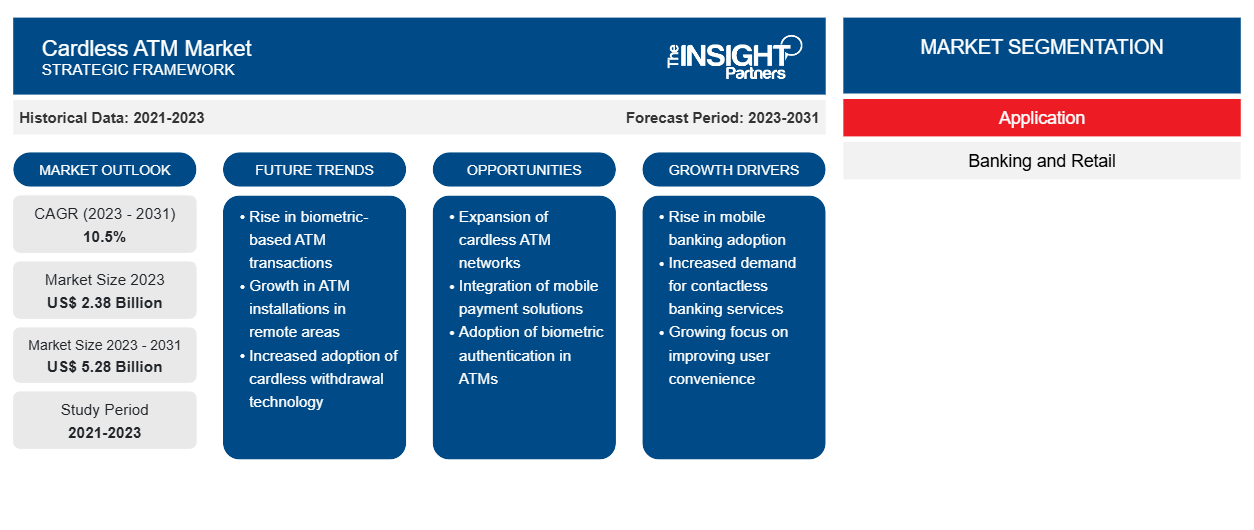Der Markt für kartenlose Geldautomaten soll von 2,38 Milliarden US-Dollar im Jahr 2023 auf5,28 Milliarden bis 2031; es wird erwartet, dass es von 2023 bis 2031 mit einer durchschnittlichen jährlichen Wachstumsrate von 10,5 % wächst. Die digitale Transformation hat auch den Bankensektor nachhaltig beeinflusst. Technologien werden eingesetzt, um die Zugänglichkeit und den Komfort für Verbraucher im Bankensektor zu verbessern. In dieser Hinsicht führen Banken auf der ganzen Welt zunehmend mobile Plattformen, digitales Banking und biometrische Authentifizierung ein, um Verbrauchern bessere und zugänglichere Lösungen anzubieten. Im Zuge dieser Entwicklungen erlebt auch der Marktanteil bargeldloser Geldautomaten weltweit einen Aufschwung.
Marktanalyse für kartenlose Geldautomaten
Die Marktprognose für kartenlose Geldautomaten wird auf der Grundlage verschiedener sekundärer und primärer Forschungsergebnisse geschätzt, wie z. B. wichtiger Unternehmensveröffentlichungen, Verbandsdaten und Datenbanken. Die digitale Technologie hat die Bankenbranche verändert und Effizienz und Zugänglichkeit verbessert. Obwohl die Finanztechnologie die Notwendigkeit häufiger Bargeldtransaktionen verringert, erleichtert sie es dem Verbraucher auch, an Bargeld zu kommen, wenn er es braucht. Kartenlose Geldautomaten ermöglichen es Kunden, Geldautomatentransaktionen über die Bank-App ihres Smartphones durchzuführen. Sie sind eine einfache Möglichkeit, Geld von einem Bankkonto abzuheben, wenn man seine Debitkarte vergisst oder die Anzahl der Male reduzieren möchte, die der Verbraucher den Bildschirm eines Geldautomaten berühren muss. Dies ist einer der Hauptfaktoren, die das Wachstum des Marktes für kartenlose Geldautomaten weltweit vorantreiben.
Kartenloser Geldautomat
Branchenüberblick
- Kartenlose Bankkonten verbessern die Sicherheit, da keine Karten mehr erforderlich sind, Transaktionsprozesse vereinfacht werden und mobile Bankdienstleistungen angeboten werden. Da immer mehr Menschen formelle Finanzdienstleistungen nutzen, konzentriert sich die Bankenbranche zunehmend auf kartenlose Bankkonten.
- Bei Geldautomaten, die physische Karten verwenden, treten Probleme wie Diebstahl, Verlust und unbefugter Zugriff auf, was den Bedarf an neuen Lösungen unterstreicht.
- Kartenlose Bankkonten, die mobile Banking-Apps und biometrische Authentifizierung nutzen, stellen eine sichere Alternative zu physischen Karten dar. Fortschrittliche Authentifizierungsmechanismen verbessern die Sicherheit und mindern die mit der Verwendung physischer Karten verbundenen Gefahren.
- Kartenlose Bankkonten sind aufgrund ihrer schnelleren Transaktionsprozesse und Benutzerfreundlichkeit beliebt. Mobile Geräte ermöglichen eine sichere Transaktionsautorisierung ohne physische Karten, was zu einer besseren Zugänglichkeit der Bankgeschäfte führt.
Passen Sie diesen Bericht Ihren Anforderungen an
Sie erhalten kostenlos individuelle Anpassungen an jedem Bericht, einschließlich Teilen dieses Berichts oder einer Analyse auf Länderebene, eines Excel-Datenpakets sowie tolle Angebote und Rabatte für Start-ups und Universitäten.
-
Holen Sie sich die wichtigsten Markttrends aus diesem Bericht.Dieses KOSTENLOSE Beispiel umfasst eine Datenanalyse von Markttrends bis hin zu Schätzungen und Prognosen.
Markttreiber für kartenlose Geldautomaten
Anstieg des Mobile Banking auf der ganzen Welt treibt den Markt für kartenlose Geldautomaten an
- Mit dem Boom des digitalen Bankings und der Online-Transaktionen in der Zeit nach der Pandemie nahm die Abhängigkeit von Geldautomaten ab. Der Einsatz von Geldautomaten wird angesichts der zunehmenden Entwicklung hin zu bargeldlosen Volkswirtschaften auf der ganzen Welt in Frage gestellt. Dies veranlasste den Bankensektor und die Geldautomatenanbieter, die Technologie zu überdenken, und veranlasste sie dazu, den Verbrauchern bargeldlose Geldautomaten anzubieten.
- Kartenlose Geldautomaten gelten als der „nächste große Trend“ im Bankwesen. Große Institute wie Bank of America und Chase haben bereits kartenlose Geldautomaten eingeführt. Wilson Kerr von Unbound Commerce meint: „Da biometrische Technologie den Smartphone-Zugang verbessert und absichert, werden Innovationen wie kartenlose Geldautomaten zur Norm.“
- Zu den neuesten Entwicklungen zählen QR-Codes in kartenlosen Geldautomaten, die sich mit beispielloser Geschwindigkeit verbreiten.
- Diese kartenlosen Geldautomaten sind wesentlich einfacher zu installieren und kostengünstiger in der Wartung. Im Dezember 2021 gab CR2, einer der weltweit führenden Anbieter von digitalen Bank- und Zahlungsplattformen, bekannt, dass er diese Zero-Touch-Lösung für Bargeldabhebungen an Geldautomaten für eine der fortschrittlichsten Banken des afrikanischen Kontinents bereitgestellt hat. Bargeldlose Geldautomaten sprechen die anspruchsvolleren Nutzer des mobilen Bankings an, und dies hat das Wachstum des Marktes für kartenlose Geldautomaten vorangetrieben.
Kartenloser Geldautomat
Marktbericht-Segmentierungsanalyse
- Basierend auf der Technologie ist der Marktbericht für kartenlose Geldautomaten in Near Field Communication (NFC), Quick-Response-Codes (QR-Codes) und biometrische Verifizierung unterteilt.
- Es wird erwartet, dass das Segment Near Field Communication (NFC) im Jahr 2023 einen bedeutenden Marktanteil bei kartenlosen Geldautomaten halten wird. Wenn der Benutzer sein Mobilgerät an einem Geldautomaten an das kontaktlose Symbol hält, startet Near Field Communication (NFC) die digitale Geldbörsen-App seines Telefons. Auf dem App-Bildschirm kann der Benutzer die Karte auswählen, die er verwenden möchte, und die PIN eingeben, um die Geldautomatentransaktion abzuschließen.
Kartenloser Geldautomat
Marktanalyse nach Geografie
Der Umfang des Marktberichts zu kartenlosen Geldautomaten ist hauptsächlich in fünf Regionen unterteilt: Nordamerika, Europa, Asien-Pazifik, Naher Osten und Afrika sowie Südamerika. Nordamerika erlebt ein schnelles Wachstum und wird voraussichtlich einen bedeutenden Marktanteil an kartenlosen Geldautomaten halten. Die bedeutende wirtschaftliche Entwicklung der Region und die zunehmende Nutzung der Mobile-Banking-Technologie treiben die Einführung kartenloser Geldautomaten in der Region voran. Laut einer Statistik von Fortunly aus dem Jahr 2023 nutzen 89 % der amerikanischen Bankkontoinhaber Mobile Banking zur Kontoverwaltung.
Kartenloser Geldautomat
Regionale Einblicke in den Markt für kartenlose Geldautomaten
Die regionalen Trends und Faktoren, die den Markt für kartenlose Geldautomaten im Prognosezeitraum beeinflussen, wurden von den Analysten von Insight Partners ausführlich erläutert. In diesem Abschnitt werden auch die Marktsegmente und die Geografie für kartenlose Geldautomaten in Nordamerika, Europa, im asiatisch-pazifischen Raum, im Nahen Osten und Afrika sowie in Süd- und Mittelamerika erörtert.

- Erhalten Sie regionale Daten zum Markt für kartenlose Geldautomaten
Umfang des Marktberichts zu kartenlosen Geldautomaten
| Berichtsattribut | Details |
|---|---|
| Marktgröße im Jahr 2023 | 2,38 Milliarden US-Dollar |
| Marktgröße bis 2031 | 5,28 Milliarden US-Dollar |
| Globale CAGR (2023 - 2031) | 10,5 % |
| Historische Daten | 2021-2023 |
| Prognosezeitraum | 2023–2031 |
| Abgedeckte Segmente |
Nach Anwendung
|
| Abgedeckte Regionen und Länder |
Nordamerika
|
| Marktführer und wichtige Unternehmensprofile |
|
Dichte der Marktteilnehmer für kartenlose Geldautomaten: Die Auswirkungen auf die Geschäftsdynamik verstehen
Der Markt für kartenlose Geldautomaten wächst rasant. Dies wird durch die steigende Nachfrage der Endnutzer aufgrund von Faktoren wie sich entwickelnden Verbraucherpräferenzen, technologischen Fortschritten und einem größeren Bewusstsein für die Vorteile des Produkts vorangetrieben. Mit der steigenden Nachfrage erweitern Unternehmen ihr Angebot, entwickeln Innovationen, um die Bedürfnisse der Verbraucher zu erfüllen, und nutzen neue Trends, was das Marktwachstum weiter ankurbelt.
Die Marktteilnehmerdichte bezieht sich auf die Verteilung der Firmen oder Unternehmen, die in einem bestimmten Markt oder einer bestimmten Branche tätig sind. Sie gibt an, wie viele Wettbewerber (Marktteilnehmer) in einem bestimmten Marktraum im Verhältnis zu seiner Größe oder seinem gesamten Marktwert präsent sind.
Die wichtigsten Unternehmen auf dem Markt für kartenlose Geldautomaten sind:
- Citigroup Inc.
- JPMorgan Chase & Co.
- Wells Fargo
- NCR Corporation
- Fujitsu
Haftungsausschluss : Die oben aufgeführten Unternehmen sind nicht in einer bestimmten Reihenfolge aufgeführt.

- Überblick über die wichtigsten Akteure auf dem Markt für kartenlose Geldautomaten
Die „Marktanalyse für kartenlose Geldautomaten“wurde basierend auf Typ, Technologie, Anwendung und Geografie durchgeführt. In Bezug auf den Typ ist der Markt in Geldautomaten vor Ort, Geldautomaten außerhalb des Standorts und andere unterteilt. Basierend auf der Technologie ist der Markt für kartenlose Geldautomaten in Near Field Communication (NFC), Quick Response (QR)-Codes und biometrische Verifizierung unterteilt. Basierend auf der Anwendung ist der Markt für kartenlose Geldautomaten in Banken und Einzelhandel unterteilt. Basierend auf der Geografie ist der Markt in Nordamerika, Europa, Asien-Pazifik, den Nahen Osten und Afrika sowie Südamerika unterteilt.
Kartenloser Geldautomat
Marktnachrichten und aktuelle Entwicklungen
Unternehmen verfolgen im Markt für kartenlose Geldautomaten anorganische und organische Strategien wie Fusionen und Übernahmen. Nachfolgend sind einige aktuelle Marktentwicklungen aufgeführt:
- Im Juni 2016 gab die Bank of America am Donnerstag bekannt, dass sie in San Antonio 19 Geldautomaten aufgestellt hat, an denen Kunden mit ihrem Smartphone Bargeld abheben können. Kunden können an kartenlosen Geldautomaten Überweisungen tätigen und Kontostände abfragen, indem sie eine auf ihrem Smartphone gespeicherte digitale Debitkarte verwenden.
[Quelle: Bank of America, Unternehmenswebsite]
- Im September 2020 entwickelte HSBC eine eigene KI-gestützte Technologie zur Optimierung der Bargeldbefüllung an seinen Geldautomaten, die inzwischen an externe Auftragnehmer ausgelagert sind. Die Technik wurde erfolgreich am 1.200 Geldautomaten umfassenden Netzwerk der Bank in Hongkong getestet. Die Bank sparte bis zu 1 Million US-Dollar, da die Zahl der Geldautomatenbefüllungen nach der Implementierung der KI-Technologie „iCash“ um 15 % zurückging.
[Quelle: HSBC Holdings Plc, Unternehmenswebsite]
Kartenloser Geldautomat
Marktberichtsabdeckung und Ergebnisse
Der Marktbericht „Marktgröße und Prognose für kartenlose Geldautomaten (2021–2031)“ bietet eine detaillierte Analyse des Marktes, die die folgenden Bereiche abdeckt:
- Marktgröße und -prognose auf globaler, regionaler und Länderebene für alle abgedeckten wichtigen Marktsegmente.
- Marktdynamik wie Treiber, Beschränkungen und wichtige Chancen.
- Wichtige Zukunftstrends.
- Detaillierte PEST- und SWOT-Analyse
- Globale und regionale Marktanalyse, die wichtige Markttrends, wichtige Akteure, Vorschriften und aktuelle Marktentwicklungen abdeckt.
- Branchenlandschaft und Wettbewerbsanalyse, einschließlich Marktkonzentration, Heatmap-Analyse, Schlüsselakteuren und aktuellen Entwicklungen.
- Detaillierte Firmenprofile.
- Historische Analyse (2 Jahre), Basisjahr, Prognose (7 Jahre) mit CAGR
- PEST- und SWOT-Analyse
- Marktgröße Wert/Volumen – Global, Regional, Land
- Branchen- und Wettbewerbslandschaft
- Excel-Datensatz
Aktuelle Berichte
Erfahrungsberichte
Grund zum Kauf
- Fundierte Entscheidungsfindung
- Marktdynamik verstehen
- Wettbewerbsanalyse
- Kundeneinblicke
- Marktprognosen
- Risikominimierung
- Strategische Planung
- Investitionsbegründung
- Identifizierung neuer Märkte
- Verbesserung von Marketingstrategien
- Steigerung der Betriebseffizienz
- Anpassung an regulatorische Trends























 Kostenlose Probe anfordern für - Markt für kartenlose Geldautomaten
Kostenlose Probe anfordern für - Markt für kartenlose Geldautomaten